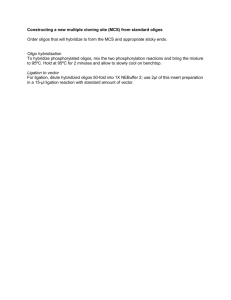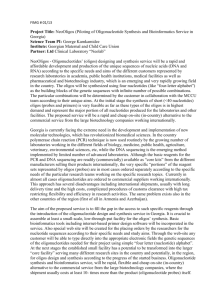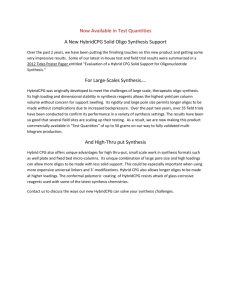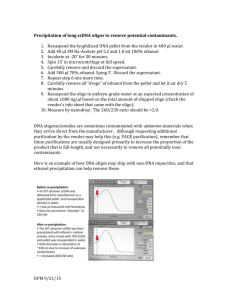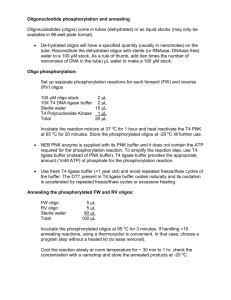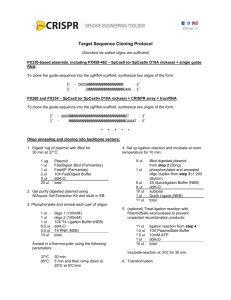beigel4
advertisement
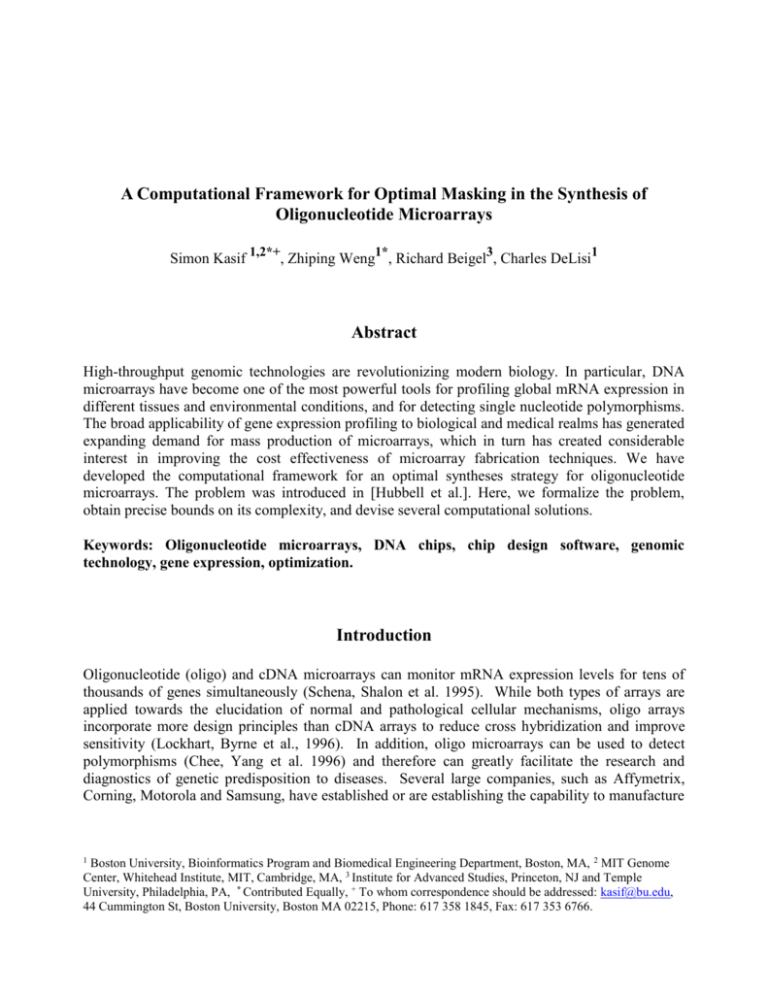
A Computational Framework for Optimal Masking in the Synthesis of Oligonucleotide Microarrays Simon Kasif 1,2*+, Zhiping Weng1*, Richard Beigel3, Charles DeLisi1 Abstract High-throughput genomic technologies are revolutionizing modern biology. In particular, DNA microarrays have become one of the most powerful tools for profiling global mRNA expression in different tissues and environmental conditions, and for detecting single nucleotide polymorphisms. The broad applicability of gene expression profiling to biological and medical realms has generated expanding demand for mass production of microarrays, which in turn has created considerable interest in improving the cost effectiveness of microarray fabrication techniques. We have developed the computational framework for an optimal syntheses strategy for oligonucleotide microarrays. The problem was introduced in [Hubbell et al.]. Here, we formalize the problem, obtain precise bounds on its complexity, and devise several computational solutions. Keywords: Oligonucleotide microarrays, DNA chips, chip design software, genomic technology, gene expression, optimization. Introduction Oligonucleotide (oligo) and cDNA microarrays can monitor mRNA expression levels for tens of thousands of genes simultaneously (Schena, Shalon et al. 1995). While both types of arrays are applied towards the elucidation of normal and pathological cellular mechanisms, oligo arrays incorporate more design principles than cDNA arrays to reduce cross hybridization and improve sensitivity (Lockhart, Byrne et al., 1996). In addition, oligo microarrays can be used to detect polymorphisms (Chee, Yang et al. 1996) and therefore can greatly facilitate the research and diagnostics of genetic predisposition to diseases. Several large companies, such as Affymetrix, Corning, Motorola and Samsung, have established or are establishing the capability to manufacture 1 Boston University, Bioinformatics Program and Biomedical Engineering Department, Boston, MA, 2 MIT Genome Center, Whitehead Institute, MIT, Cambridge, MA, 3 Institute for Advanced Studies, Princeton, NJ and Temple University, Philadelphia, PA, * Contributed Equally, + To whom correspondence should be addressed: kasif@bu.edu, 44 Cummington St, Boston University, Boston MA 02215, Phone: 617 358 1845, Fax: 617 353 6766. microarrays in large quantities. Thus, reductions in cost or time to manufacture can have a significant impact on biotechnology and medicine. cDNA microarrays are produced by spotting pre-made cDNA solutions onto a glass or nylon surface via physical contact or ink-jet deposition. While oligonucleotides can also be synthesized and then spotted, oligo microarrays are usually manufactured by in situ synthesis, primarily via photolithography (Lipshutz, Fodor et al. 1999), and more recently by ink-jet deposition (Blanchard 1998). In situ synthesis involves the consecutive addition of A, C, G and T nucleotides to the appropriate spots on the microarray. An important advantage of photolithographic synthesis over ink-jet deposition is that in a single cycle of synthesis a nucleotide can be added to all desired spots on the array. This is achieved via photodeprotection of the target spots on the array surface with ultraviolet (UV) light prior to the addition of the nucleotide. Meanwhile, non-target spots must be protected from the UV light using physical or virtual masks. The fabrication of physical masks is a laborious and costly process, and one mask is needed for each cycle of synthesis for each variety of arrays. Singh-Gasson and colleagues used a digital micro-mirror device to reflect light selectively onto the desired spots of an array – the “virtual masking” strategy (Singh-Gasson, Green et al. 1999). Nonetheless, the deprotection step for each cycle lasts approximately five minutes, and photolabile nucleosides are expensive. Therefore, decreasing the number of cycles required to synthesize a given set of sequences can reduce time and cost. Here, we address optimization synthesis; i.e. optimizing the order of nucleotide addition. The simplest strategy for synthesizing a given set of sequences is to add A's wherever appropriate as the first base, then C's, then G's, then T's, then to repeat this process for the second base, and so on. Chee et al. (1996) noted that if K is the length of the longest oligonucleotide to be synthesized, maximally 4K cycles are required. Hubbderell et al. (1999) observed that it would be possible to skip a synthesis cycle if a base is not needed by any oligonucleotides, or if the oligonucleotides that require the base can still be synthesized when that base is presented again later. Tolonen et al. (personal communication) observed that the synthesis could be accelerated, even for a large set of oligonucleotides, if the order of base addition is tailored according to the oligonucleotide sequences. Consequently, oligonucleotides can vary in length by more than one base at the end of every synthesis cycle. This observation has motivated the development of an optimal base-addition strategy described in this paper. A Computational Framework for Optimal Synthesis Strategy We formulate the question of devising an optimal synthesis strategy in oligo microarrays as a combinatorial state-space search problem. This computational formulation provides insight into the complexity of the problem and enables a range of discrete optimization and heuristic search solutions. In this paper, we assume the input to the optimization software is a collection of N oligos of arbitrary lengths, which have been pre-selected in a probe selection process. For simplicity, we discuss the case of uniform length K-mers, but our framework is readily applicable to the more general case. An optimal synthesis strategy involves L cycles of synthesis where in each cycle a single nucleotide is added to all unmasked oligos. The exact spatial location of each oligo on the array is not important, as long as it can be retrieved during actual synthesis. Therefore, we assume that the input to the optimization code is a list of oligos arranged in one dimension, such as shown 2 in Figure 1a. We define a strategy for constructing K-mers in L cycles as an L-long vector S, with elements A, C, T or G. S[j] is the nucleotide added in cycle j. For instance, the vector [A, C, A, T, G] corresponds to using A, C, A, T and G in cycles 1, 2, 3, 4 and 5, respectively. We define the height of each partially constructed oligo as the number of nucleotides that have been added thus far by the synthesis strategy. We define a frontier F of a partially synthesized array to be an integer vector of size N where F[i] = the height of the i-th oligo thus far. For example, the frontier of the four oligos in Figure 1b is F = [3,1,1,2]. The “traditional” way to create a chip of N oligos of height K each is by performing 4K cycles of synthesis. After adding A, C, G, and T to the appropriate spots of the array, all oligos will be onebase long. We then proceed to synthesize layer two in four cycles and all oligos will be two-bases long. We continue until the entire chip is synthesized in 4K cycles. It is easy to observe that by a slight modification of the order of base-addition (Tolonen et al.), we can expedite the above process. For example (Figure 1c), we can synthesize an array of K=3 in four cycles using a modified synthesis strategy, compared to six cycles in the “traditional” approach. In order to introduce the optimization framework for masking we need to measure the “work” that has been accomplished after several cycles of synthesis. We therefore give two definitions of “frontier height”. 1. The Min-Height of a frontier constructed after L cycles is the length of the shortest oligo. In Figure 1b, Min-Height (L) = 1. 2. The Sum-Height of a frontier is the sum of the lengths of all oligos constructed so far. In Figure 1b, Sum-Height (L) = 3 + 1 + 1 + 2 = 7. The objective optimization criterion we desire to minimize is the number of cycles required to create a frontier of Min-Height = K. That is, we seek the shortest-length strategy vector that is sufficient to synthesize all oligos on the chip. It is obvious that the best possible strategy for a Kmer oligo chip is of length between K and 4K. It is easy to construct an artificial example where the shortest strategy is of length 4K (Figure 2a). In general, as the number of oligos on a chip grows, we expect the length of the optimal strategy vector to grow as well. Heuristic Search Solutions An obvious heuristic solution to devising the optimal synthesis strategy is a greedy search. In each synthesis cycle, we consider the four different options to extend the current layout and compute the height of the resulting frontier for each option. We choose the nucleotide that maximizes the height of the frontier, which could be either Min-Height or Sum-Height. The Min-Height heuristic extends the shortest oligo. The Sum-Height heuristic chooses the nucleotide that will add the largest number of nucleotides to the chip. The simple examples in Figures 2b and 2c show that greedy search is not guaranteed to produce an optimal solution using either the Min-Height or the Sum-Height heuristic. In the remainder of this section, we consider ways to improve the greedy search. In the next section, we show that an efficient polynomial time solution is unlikely to exist for this optimization problem. We then report simulation results that describe the effectiveness of the Sum-Height heuristics. 3 Look-Ahead Solution A natural way to extend the greedy algorithm is to consider a look-ahead strategy. 1. Generate all possible frontiers that can be generated in L cycles. The number of strategies is 4L. The number of frontiers might be smaller since different strategies may generate the same frontier. 2. For each frontier compute the height. 3. Choose (for the first cycle) the strategy that maximizes the height after L cycles. 4. Repeat until all oligos have been synthesized. When L = 4K this algorithms performs an exhaustive search. A rough upper bound on the running time of this algorithm is O(4LN) which makes it prohibitive for large values of L. An alternative approach would be to use a variant of best-first search such as A* (a popular algorithm in the Artificial Intelligence community). A more space-efficient alternative would be to use a branchand-bound formulation, a standard approach in Discrete Optimization. Local Search Solution Local search attempts to improve a given solution by a series of local perturbations until a minimum is achieved. One obvious local search approach for our problem would be to repeatedly change a selected nucleotide in the strategy vector, and accept the new strategy if it results in an improvement over the previous one. Here, we implement a variant (Figure 3) based on steepest descent. The steepest descent algorithm considers every possible local perturbation of a single nucleotide in all positions of the strategy vector, and chooses the move that results in the greatest improvement. This algorithm terminates relatively quickly since there are at most M possible improvements to be made. Each iteration (Steps 1-2) requires time O(M), so the total running time is O(M2). A simple classical variant of this algorithm is to accept a new strategy with some probability even if no improvement is observed. A Gibbs Sampler is a special case of this solution when the probability of acceptance is a function of the degree of improvement, and positions for possible perturbations are selected at random rather than sequentially as described above. We describe simulation results using local search below. Computational Analysis of Optimal Synthesis Strategy In this section, we provide a set of computational reductions that allow us to obtain a precise characterization of the complexity of the optimal synthesis strategy. We see this part as the main contribution of this paper. Multiple-Sequence Alignment Formulation We first observe that the optimal masking problem can be reduced to a special case of multiple sequence alignment (Waterman 1995; Gusfield 1997). In particular, the best L-cycle synthesis 4 strategy directly corresponds to the optimal multiple alignment of the N-oligos where the cost of the alignment are defined as follows: 1. replacement cost = +∞, 2. deletion cost = +∞, 3. insertion cost = +1. That is, the only allowed “editing” operation is inserting a gap. We first demonstrate this principle with an example. For the oligo design problem in Figure 2b, we first align the two oligos: CCCAAA AAACCC An optimal alignment is given by: CCCAAA AAACCC Walking across the alignment from left to right creates the following synthesis strategy: [CCCAAACCC]. Another optimal strategy is [AAACCCAAA]. The formal proof of this equivalence is not difficult. Each strategy corresponds to a multiple alignment obtained by aligning each sequence against the strategy sequence. Therefore, the shortest strategy corresponds to the shortest global alignment. This observation enables the applications of computational solutions developed in multiple sequence analysis such as dynamic programming, Gibbs sampling and iterative refinement (Waterman 1995; Gusfield 1997). A common greedy solution is based on aligning each pair, then producing a strategy based on the best-aligned pair and subsequently continuing to add oligos to the alignment in the best-first manner. Shortest Super-Sequence Formulation The above observation is useful for obtaining insight into the problem. By reducing our problem to a special case of multiple-sequence alignment, we show that multiple alignment is “harder”, which does not preclude the possibility of an efficient solution to our specific problem. Here we show that the optimal synthesis strategy problem is exactly equivalent to the problem of computing the shortest super-sequence of a collection of strings. This two-way reduction establishes our problem to be as hard as the shortest super-sequence problem, which is known to be NP-hard. We informally define sequence X to be a super-sequence of sequence Y if every character of Y occurs in X in the same order as they occur in Y. Similarly, we define a super-sequence of a collection of sequences where the above condition has to hold for each of the sequences. For instance, AAAACCCTTTT is a super-sequence of ACT, AAACCCT and AAAATTT. Sequence X is the shortest super-sequence of a collection of sequences if and only if its length is the shortest among all super-sequences of the collection. 5 Since the synthesis strategy must be a super-sequence of each of the oligos, the optimal synthesis strategy vector is equivalent to the shortest super-sequence of all oligos. The shortest supersequence problem is known to be NP-hard (Jiang and Li 1998) and therefore the reduction above formally establishes the optimal synthesis strategy problem to be NP-hard. More explicitly, the problem of finding a masking strategy of length less than L, given a collection of N oligos of length K, is NP-complete. This is an important observation since it implies that optimal synthesis strategy is unlikely to have efficient (sub-exponential) optimal solutions for large number of oligos. It is easy, of course, to devise relatively efficient dynamic programming solutions when the number of oligos is constant (e.g, smaller than ten). Simulations with Random Oligos We have conducted a large number of simulations to estimate the performance of several heuristic approaches to devising an optimal synthesis strategy. Here we report our results with three heuristic approaches: 1. Oblivious Strategy: We simply repeat synthesizing ACGTACGT… independent of the input sequences. 2. Max-Sum-Height Heuristics: We choose the nucleotide that maximizes the Sum-Height in the next cycle (as outlined above). 3. Randomized Local Search Improvement: Once a solution is obtained by the above two methods we attempt to improve the solution using local search. Our results comparing the oblivious and Max-Sum-Height heuristics are summarized in Table 1. It is clear that for random oligos there is no significant difference in performance between MaxHeight and Oblivious heuristics. It is not particularly surprising for random oligos since roughly speaking every layer in the chip contains approximately an equal number of nucleotides of each type (A, C, G, T). Moreover, our results for “real” oligos appear to be consistent with this performance (data not shown). Note that one of the criteria for selecting oligos aims to prevent cross-hybridization between mRNA and multiple oligos. This puts “selective pressure” on the design to ensure that oligos are as different as possible. As the number of oligos on the chips grows they behave more and more like random oligos. We have interpolated the expected length of a strategy for 10000 oligos and it appears to fit the following function well: f ( K ) 2.5K 4.04 K where K is the height of the oligos. Figure 4 shows an essentially linear fit of the data. The graph was produced by fitting the function f ( K ) 2.5K C K where C is the single adjustable parameter. As a result, the fit is linear. The formal derivation that proves this expectation for Max-Sum-Height is implied by the analysis in (Jiang and Li 1998). 6 Now we provide a brief motivation for the above interpolating function. When we find the shortest alignment of a single random oligo X1X2…XK with ACGTACGT…, X1 aligns with the first, second, third, or fourth base, X2 aligns with the first, second, third, or fourth base after X1, X3 aligns with the first, second, third, or fourth base after X2, etc. Thus the expected distance between Xi and Xi+1 is (1+2+3+4)/4 = 2.5. For example, if Xi = C, then the distance between Xi and Xi+1 is 1 if Xi+1 = T, 2 if Xi+1 = G, 3 if Xi+1 = A, or 4 if Xi+1 = C. The variance of the above possible distances is 1.25. Therefore, we expect X1X2…XK to require an alignment of length 2.5K, and by the Law of Large Numbers a random oligo X1X2…XK requires an alignment of length at most 2.5K O( K ) with high probability. In order to align N oligos, length 2.5K O(log( N ) K ) suffices with high probability. For a fixed number of oligos, the logarithm term is constant. Therefore, we can use the formula 2.5K O( K ) . We also used a simple local search to improve the solutions produced by the Max-Sum-Height and Oblivious strategies. The results are given in Table 2. We found that when the number of oligos is small (e.g, 100) the improvement was better (approximately 3-5%). However, as the number of oligos grows (e.g, 1000) the percentage of improvement was reduced to about 1-1.5%. This is interesting since Gibbs Sampling is a close relative of local search and is a popular algorithm for multiple-sequence alignment. However, in typical multiple alignment of proteins we often align tens to hundreds of sequences. In this paper, we need to “align” thousands to hundreds of thousands of oligos and it appears to have an impact on the degree of improvement obtained with this approach. Conclusions In this paper, we have presented a computational formalization of the optimal synthesis strategy of oligonucleotide microarrays. We have showed that the problem is computationally intractable (NPcomplete). We have provided several simulation results that shed light on its practical complexity. As the number of applications of oligo microarrays increases and their use in diagnostic medical applications becomes a common practice, we expect the design of DNA chips to become more sophisticated and efficient. Our main conclusion from both the theoretical and simulation analyses provided in this paper is that the problem of optimal masking appears to be computationally difficult. Moreover, the simplest possible solution appears to work almost as well as more sophisticated approaches that include heuristic greedy approaches and local search. It would be interesting to see if more exhaustive approaches based on best-first search, branch-and-bound or Gibbs Sampling methods will generate a more dramatic improvement in performance. Naturally, these results must be confirmed in the context of practically used DNA chips. Acknowledgments Simon Kasif is supported in part by NSF grants IRI- 9616254 and KDI- 9980088. Zhiping Weng is supported in part by NSF grants DBI-0078194 and DBI-0078194. Richard Beigel is supported in part by NSF grants CCR-9996021 and CCR-0019019, a Temple University study leave, and a grant from the State of New Jersey. 7 References Blanchard, A. (1998). “Synthetic DNA arrays.” Genet Eng 20: 111-23. Chee, M., R. Yang, et al. (1996). “Accessing genetic information with high-density DNA arrays.” Science 274(5287): 610-4. Jiang T. and Li M. (1997), "On the approximation of shortest common supersequences and longest common subsequences", SIAM J. Comput. 24:5, 1122-1139. D. Gusfield (1997), "Algorithms on Strings, Trees, and Sequences: Computer Science and Computational Biology", 1997, Cambridge University Press, New York. Hubbell EA, Morris MS, Winkler JL, Computer-aided engineering system for design of sequence arrays and lithographic masks, United States Patent 5,856,101, January 5, 1999. Lipshutz, R. J., S. P. Fodor, et al. (1999). “High density synthetic oligonucleotide arrays.” Nat Genet 21(1 Suppl): 20-4. Lockhart, D.J., Dong, H., Byrne, M.C., Follettie, M.T., Gallo, M.V., Chee, M.S., Mittmann, M., Wang, C., Kobayashi, M., Horton, H. et al. (1996) "Expression monitoring by hybridization to high-density oligonucleotide arrays". Nat Biotechnol, 14, 1675-1680. Schena, M., D. Shalon, et al. (1995). “Quantitative monitoring of gene expression patterns with a complementary DNA microarray.” Science 270(5235): 467-70. Singh-Gasson, S., R. D. Green, et al. (1999). “Maskless fabrication of light-directed oligonucleotide microarrays using a digital micromirror array.” Nat Biotechnol 17(10): 974-8. Tolonen, A. C., Albeanu, F. et al. (In review by Nucleic Acid Research). “Optimized in-situ construction of oligo-mers on an array surface.” Waterman (1995), "Introduction to Computational Biology: Maps, Sequences, and Genomes", 1995, Chapman & Hall, New York. 8 Figure Caption Figure 1: Formulation of synthesis strategy. a. Four 3-mer oligonucleotides. b. Four partially constructed oligos, defining frontier F = [3, 1, 1, 2]. c. The synthesis strategy [A, C, G, T] can synthesize the produce the array in four cycles, instead of six cycles required by the traditional approach. Figure 2: Example arrays that challenge synthesis strategies. a. A worst-case scenario requiring 4K stages for K-mer synthesis. b. The optimal solution for this chip requires 9 cycles whereas the greedy solution produces a 12-cycle strategy. However, the Sum-Height based greedy solution produces the optimal synthesis strategy. c. For this example, Sum-Height heuristics creates an 8cycle strategy: AATAATAA. Exhaustive search produces a 7-cycle strategy: ATAATAA. Figure 3: A local search Algorithm. Figure 4: A linear fit of the function f ( K ) 2.5K 4.04 K to the simulation data produced by the oblivious strategy for 1000 oligos. The scaling constant (4.04) depends on the total number of oligos. 9 K 10 20 40 60 80 100 10000 Max-SumHeight 37.4 Standard Deviation 0.70 37.7 Standard Deviation 0.95 20000 37.9 0.74 38.2 1.14 -3 30000 37.7 0.67 37.9 0.32 -2 40000 38.0 0.67 38.1 0.57 -1 10000 68.1 0.57 67.7 1.25 4 20000 69.0 0.67 68.7 0.67 3 30000 69.7 0.67 70.7 0.82 -10 40000 69.7 1.06 70.1 1.20 -4 10000 125.6 1.26 127.1 2.47 -15 20000 126.9 1.20 127.8 1.32 -9 30000 127.5 1.08 129.5 2.92 -20 40000 128.2 1.14 129.5 2.51 -13 10000 181.3 1.49 183.2 2.94 -19 20000 183.3 1.42 184.0 1.33 -7 30000 183.8 1.69 184.3 1.77 -5 40000 184.8 1.81 185.4 2.72 -6 10000 235.1 1.66 238.7 2.50 -36 20000 237.8 1.87 240.9 3.63 -31 30000 238.2 1.55 240.1 3.21 -19 40000 240.3 1.89 242.7 3.16 -24 10000 290.6 2.01 291.8 2.10 -12 20000 292.6 2.17 294.1 2.33 -15 30000 293.3 1.49 295.8 2.57 -25 40000 294.6 1.17 296.6 2.27 -20 N ACGT ADV -3 Table 1: Comparison of the oblivious strategy with the Max-Sum-Height heuristic. For each approach, we list the length of a strategy averaged over 10 experiments and the standard deviation. We also give the cumulative savings in nucleotides over 10 experiments (the ADV column). Note that the standard deviation is higher for the oblivious strategy (ACGT). K and N are the length and number of oligos on the microarray, respectively. 10 K 10 20 40 N MSH MSH-LS ACGT ACGT-LS 100 33.1 32.6 34.6 32.5 1000 35.9 35.7 36.1 35.7 100 62.3 61.1 63.3 60.6 1000 65.4 65.3 65.9 64.7 100 115.4 114.6 117.3 114.2 Table 2: Results of using local search improvement (LS) for both Max-Sum-Height (MSH) and oblivious solutions (ACGT). K and N are the length and number of oligos on the microarray, respectively. 11
